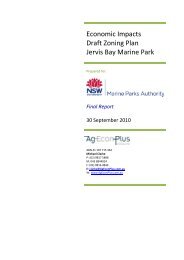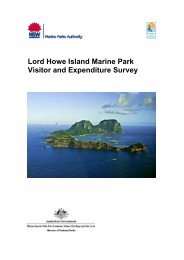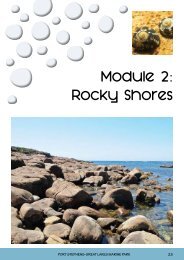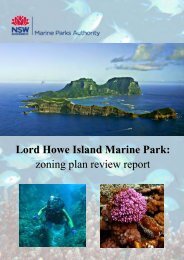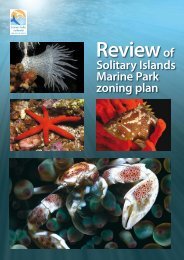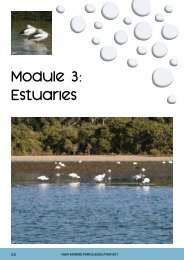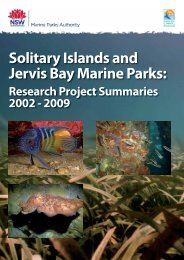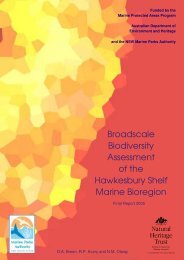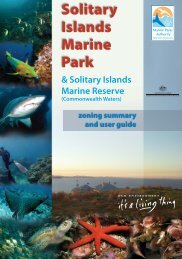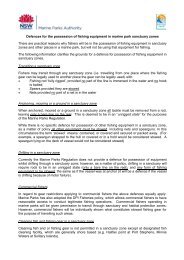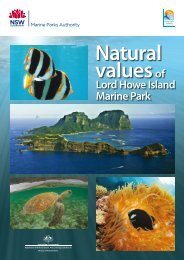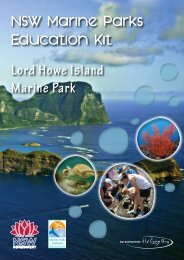Natural values of the Solitary Islands Marine Park - Marine Parks ...
Natural values of the Solitary Islands Marine Park - Marine Parks ...
Natural values of the Solitary Islands Marine Park - Marine Parks ...
- No tags were found...
You also want an ePaper? Increase the reach of your titles
YUMPU automatically turns print PDFs into web optimized ePapers that Google loves.
3 Ecosystems and habitatsBiological diversity can be described and classified at a number <strong>of</strong> levels, andinformation about <strong>the</strong> spatial distribution <strong>of</strong> biodiversity at most levels is very limited.The Integrated <strong>Marine</strong> and Coastal Regionalisation <strong>of</strong> Australia (IMCRA v4.0) is a spatialframework for classifying Australia’s marine environment into bioregions that areecologically based and are at a scale useful for regional planning (Commonwealth<strong>of</strong> Australia 2006). They are based on collated data and inferred patterns across avariety <strong>of</strong> spatial scales and assist in <strong>the</strong> description <strong>of</strong> ecosystem boundaries andprovide a framework for subsequent finer levels <strong>of</strong> planning and management. Thisbuilds on <strong>the</strong> inshore regionalisation (IMCRA v3.3) which defined bioregions using arange <strong>of</strong> biological and physical information (ANZECC TFMPA 1998a). This hierarchicalclassification has been used by all governments in Australia to develop a NationalRepresentative System <strong>of</strong> <strong>Marine</strong> Protected Areas (ANZECC TFMPA 1998b).Fur<strong>the</strong>r classification <strong>of</strong> estuarine and ocean environments can be applied at <strong>the</strong>following levels:• ecosystem: a dynamic combination <strong>of</strong> plant and animal communities and <strong>the</strong>irenvironment interacting as a functional unit;• habitat: a specific type <strong>of</strong> environment inhabited permanently or temporarily byorganisms, and based on factors such as substrate type and tidal exposure;• community: a number <strong>of</strong> species occupying a particular habitat or area;• estimated distributions and abundances <strong>of</strong> species and populations.Physical parameters such as ocean currents, climate, bathymetry and coastalgeomorphology result in <strong>the</strong> formation <strong>of</strong> many types <strong>of</strong> marine ecosystems, whichsupport a variety <strong>of</strong> habitats, communities and populations <strong>of</strong> animals and plants.These ecosystems are interconnected as species move between <strong>the</strong>m and currentspass in and out <strong>of</strong> <strong>the</strong> marine park, transporting larvae, sediments and nutrients. Theecosystems can be broadly split into oceanic and estuarine ecosystems, which arefur<strong>the</strong>r divided into smaller units based primarily on <strong>the</strong> dominant geomorphology,aquatic vegetation, benthos or depth, and distance <strong>of</strong>fshore.The most distinct separation <strong>of</strong> assemblages occurs between habitats which are:• consolidated: that is, made up <strong>of</strong> rocky reef;• unconsolidated: s<strong>of</strong>t-sediment that generally consists <strong>of</strong> mostly sand, silt or mud.Unconsolidated habitats can be fur<strong>the</strong>r divided based on <strong>the</strong> presence or absence<strong>of</strong> vegetation cover (e.g. seagrass), sediment size and composition, <strong>the</strong> dominantseagrass species and <strong>the</strong> spatial structure. Such separation recognises that differentspecies <strong>of</strong> seagrass, or those <strong>of</strong> varying density, <strong>of</strong>ten contain different assemblages <strong>of</strong>fish (Ro<strong>the</strong>rham and West 2002) and invertebrates (Webster et al 1998).The distribution and structure <strong>of</strong> consolidated habitats can vary widely, primarilydue to differences in rock type and size (e.g. boulders), complexity (e.g. gutters, walls,pinnacles) and patchiness.As detailed spatial information on <strong>the</strong> distribution <strong>of</strong> many individual species islimited in <strong>the</strong> marine park, ecosystems and habitats are used as ‘surrogates’ for speciesdiversity in <strong>the</strong> planning process. Surrogates are components shown or assumed to berelated to biological diversity that are more easily measured or more capable <strong>of</strong> beingmapped than species diversity itself. The distribution and measures <strong>of</strong> biodiversity areinferred from <strong>the</strong> distribution and measures <strong>of</strong> surrogates.



